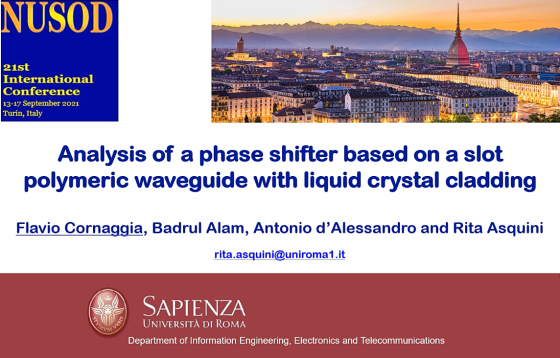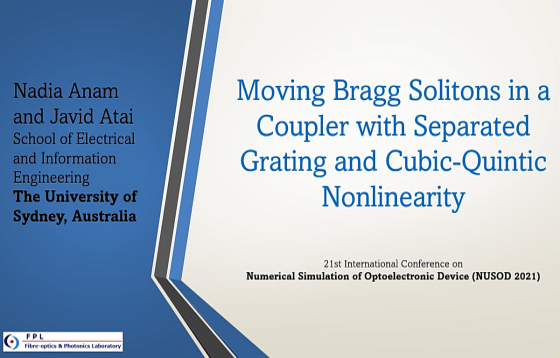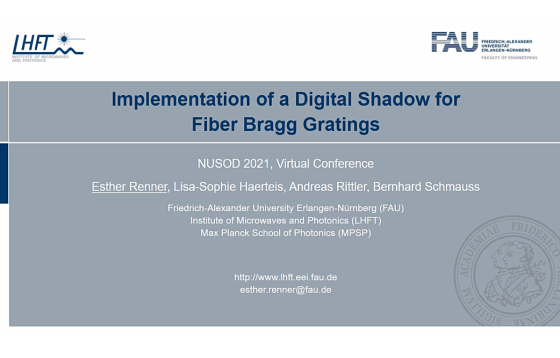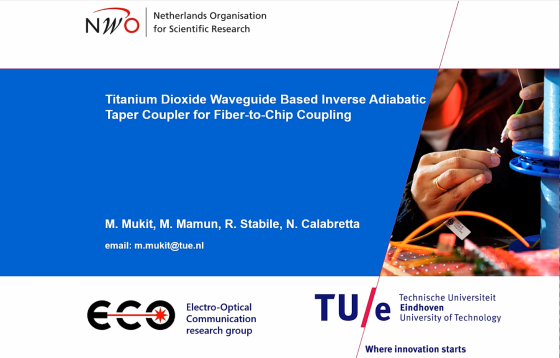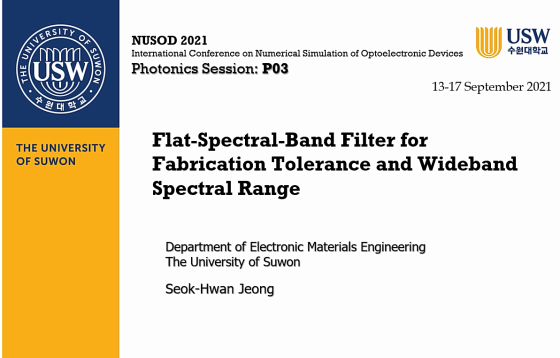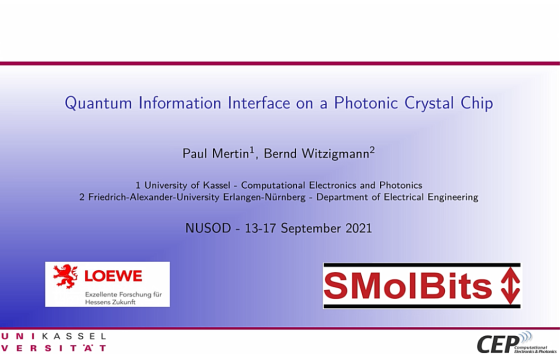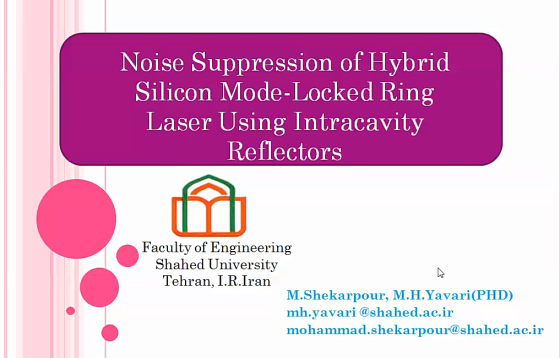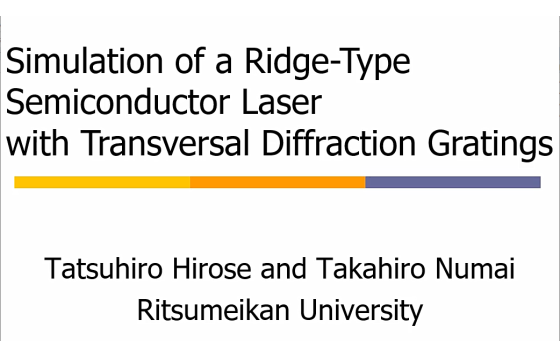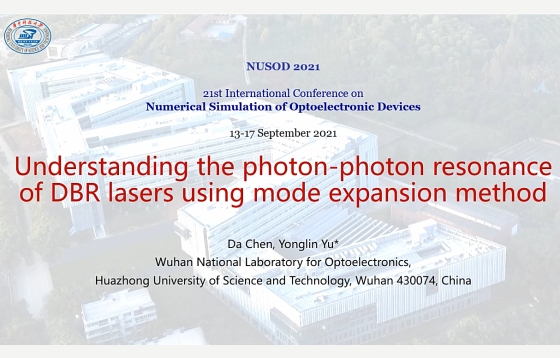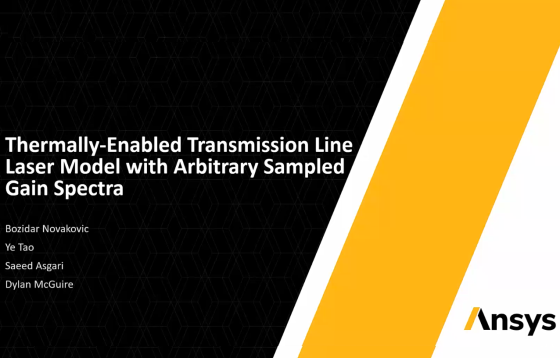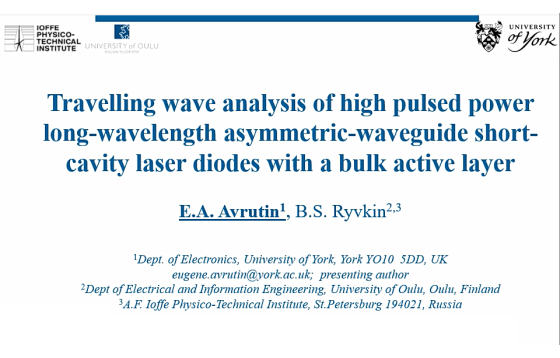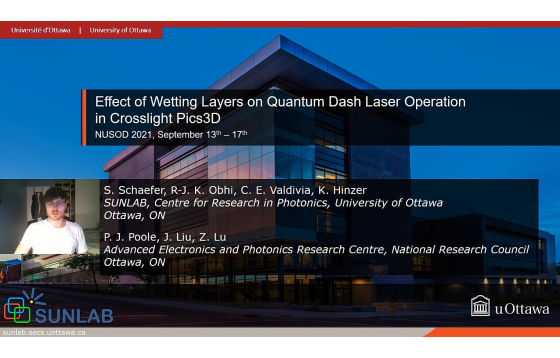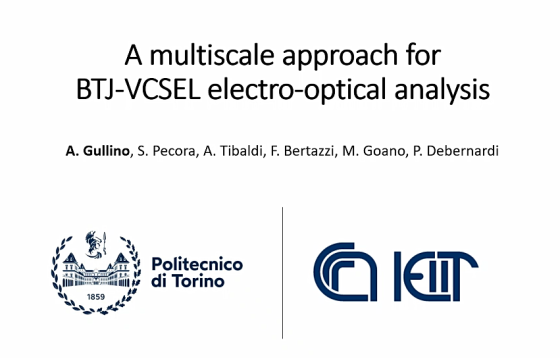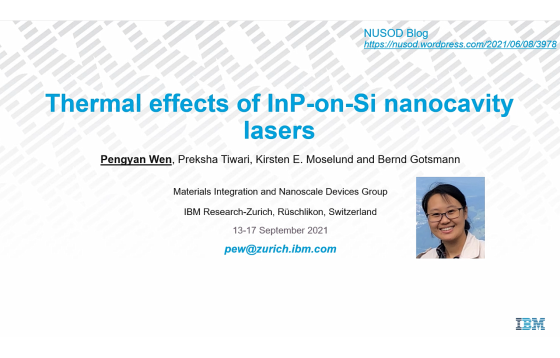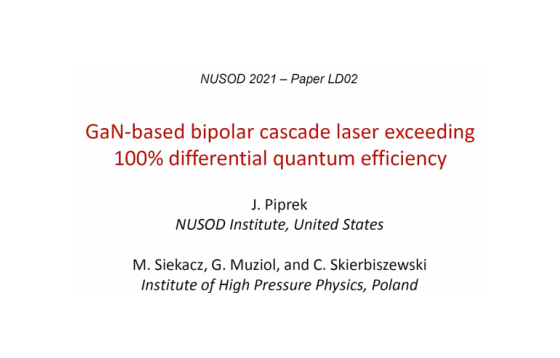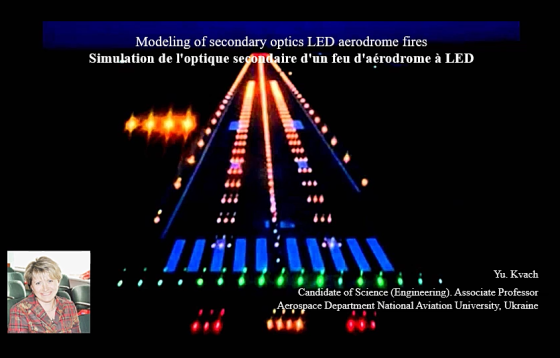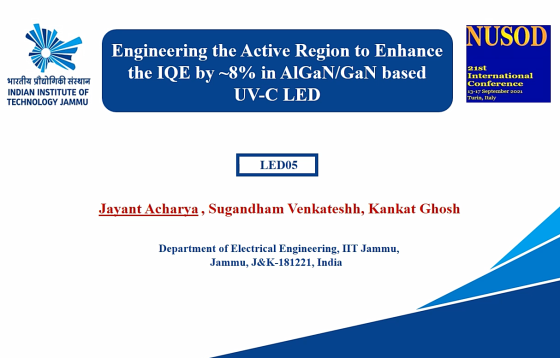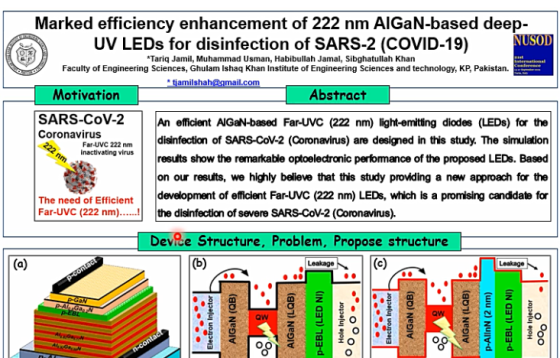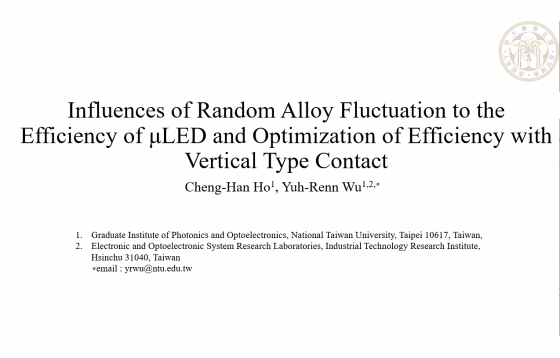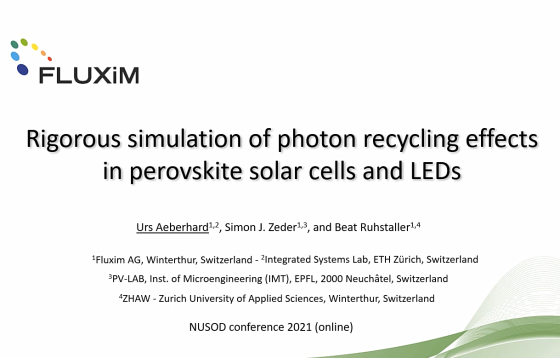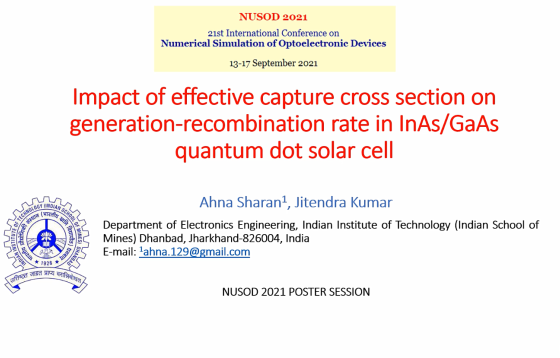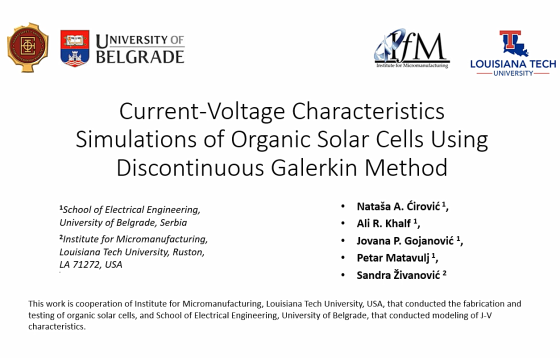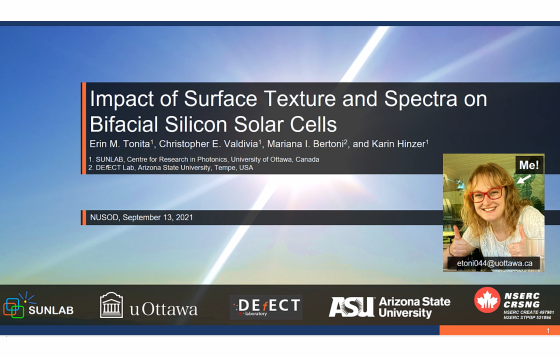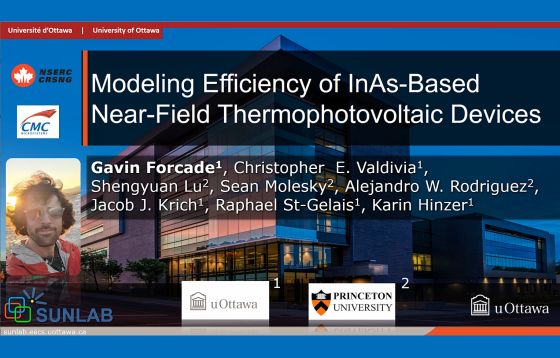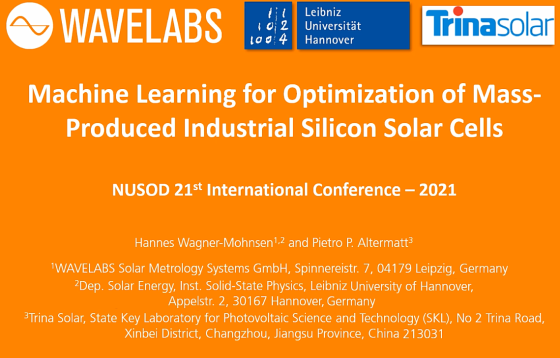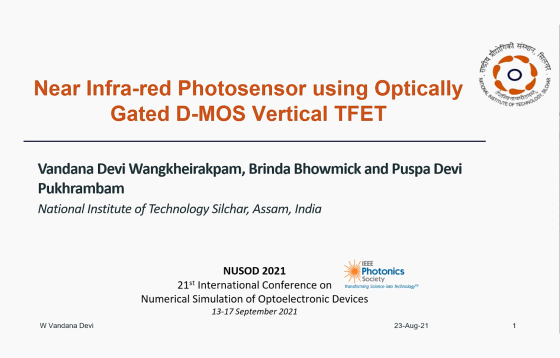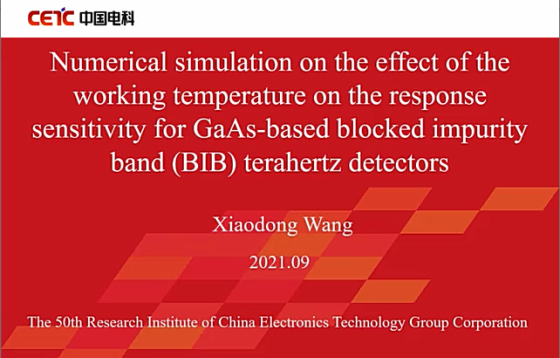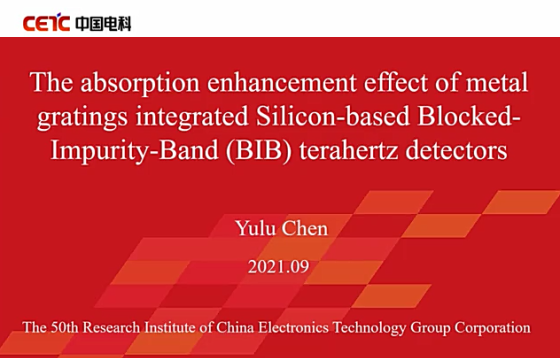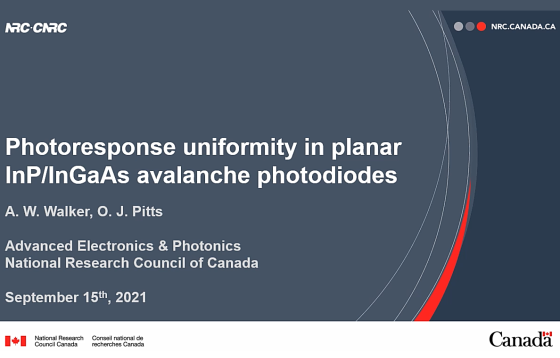


We numerically investigated a phase shifter based on a polymeric platform by using two different approaches. The device consists of a polymeric slot waveguide covered with an organic liquid crystal cladding, which is a promising configuration for the implementation of polymeric waveguide systems for computation, communication and sensing. Two different nematic liquid crystals have been […]
P06–Moving Bragg Solitons in a Coupler with Separated Grating and Cubic-Quintic Nonlinearity
We investigate the existence and stability of moving solitons a semilinear directional coupler where one core has cubic-quintic nonlinearity and the other core is linear with uniform Bragg grating.
P05–Implementation of a Digital Shadow for Fiber Bragg Gratings
We propose a synthesis model for fiber Bragg gratings (FBGs) to monitor temperature measurement errors due to aging behavior. This approach might be called a Digital Shadow since we are able to monitor all essential parameters of the grating to perform error prediction and consequently compensation. The model is tested during accelerated aging experiments, which […]
P04–Titanium Dioxide Waveguide Based Inverse Adiabatic Taper Coupler for Fiber-to-Chip Coupling
We present an efficient fiber-to-chip coupling method for polarization independent single mode titanium dioxide-TiO2 waveguide. The proposed inverse adiabatic taper coupler between a lensed fiber and waveguide consists of a spot size converter and allows coupling efficiency of around 85%.
P03–Flat-Spectral-Band Filter for Fabrication Tolerance and Wideband Spectral Range
Novel scheme for silicon-wire type flat-topped wavelength filter is proposed and theoretically verified. Multimode interference couplers with symmetric and asymmetric splitting ratios used in a delayed interference type filter made filtering spectra flat over wide wavelength range of >80 nm with potentially better production yield
P02–Quantum Information Interface on a Photonic Crystal Chip
Quantum systems for information processing rely on the distribution of quantum information in a network. Lanthanide complexes coupled to an optical cavity can act as an interface between a stationary and a flying QuBit. Here we show that in such a system the stationary quantum information can be mapped onto a photon, paving the way […]
LD12–Noise Suppression of Hybrid Silicon Mode-Locked Ring Laser Using Intracavity Reflectors
We have proposed harmonically hybrid silicon mode-locked ring laser using intracavity reflectors (ICR’s) to suppress supermode noise. The dynamic and noise propertiesof ring laser for without-reflector structures (WOICRS) and proposed structure (PS) are investigated using a delay differential equation model (DDE).
LD11–Simulation of a Ridge-Type Semiconductor Laser with Transversal Diffraction Gratings
This paper reports on improvement of stability of the fundamental horizontal transverse mode in a ridge-type semiconductor laser by incorporating transversal diffraction gratings. Kinks do not appear in current versus light-output curves by appropriately designing the number of the grating periods when the mesa width is 5 µm.
LD10–Optical Feedback Regimes Suitable for Distance Measurement with a Ring Laser
We numerically study the behavior of a ring laser subject to bidirectional delayed optical feedback, when the isolated laser is in the quasi-unidirectional regime. We find different regimes, two of which are of special interest, because the laser switching period, between the clockwise and the counter-clockwise mode, is linearly related to the time of flight […]
LD09–Understanding the photon-photon resonance of DBR lasers using mode expansion method
Photon-photon resonance (PPR) in DBR lasers is studied by numerical simulations, which are based on the mode expansion and the rate equations. It is found that the photon number and the mode coupling factor play important roles to understand physical mechanism of the PPR behind.
LD08–Thermally-Enabled Transmission Line Laser Model with Arbitrary Sampled Gain Spectra
In this paper we demonstrate a directly coupled opto-electro-thermal (OET) transmission line laser model (TLLM) for edge emitting laser simulations and its comparison to physical simulations and measurements. Our results show that the OET TLLM has comparable computational efficiency to the standard opto-electronic (OE) TLLM and can include self-heating effects with good accuracy. As such […]
LD07–Travelling wave analysis of high pulsed power long-wavelength asymmetric-waveguide short-cavity laser diodes with a bulk active layer
An effective one-dimensional travelling wave model is used to analyse the performance of a short-cavity asymmetric waveguide high pulsed power laser diodes. The effect of longitudinal inhomogeneity is proven to be modest for practical laser designs.
LD06–Effect of Wetting Layers on Quantum Dash Laser Operation in Crosslight PICS3D
We discuss the integration of quantum dashes (QDashes) into laser simulations using Crosslight Pics3D, outlining the approach for developing a model featuring asymmetrical active regions. The importance of including wetting layers to accurately represent carrier transport is investigated using results obtained for an InAs/InP QDash laser. While leakage current across the active region is unaffected […]
LD04–A multiscale approach for BTJ-VCSEL electro-optical analysis
This paper presents a theoretical comparison of the electro-optical characteristics of 850 nm GaAs/AlGaAs pinand BTJ-based VCSELs. The calculations are based on a drift-diffusion model coupled with a NEGF formalism, able to model accurately the tunneling across the TJ. The resulting LIV characteristics demonstrate promising improvements, at both 25 and 80 ◦C, enabled by TJ […]
LD03–Thermal and optical simulation of InP on Si nanocavity lasers
Accurate prediction of thermal effects is important for scaled photonic devices as excessive heating may lead to device failure. This paper addresses numerical modeling of thermal properties of InP nanocavity lasers on Si combined with optical simulations in Lumerical and lasing threshold measurements. Different geometries with diameters ranging from 200 nm to 2 µm are […]
LD02–GaN-based bipolar cascade laser exceeding 100% differential quantum efficiency
Worldwide research efforts have been focusing on quantum efficiency enhancements of GaN-based light emitters. A promising approach is the separation of multiple active regions by tunnel junctions, enabling electron-hole pairs to generate more than one photon. Utilizing advanced numerical device simulation, we here analyze internal physics and performance limitations of such InGaN/GaN bipolar cascade laser […]
LED06–Modeling of secondary optics LED aerodrome fires
The development of LED technology has allowed the Ukrainian Association of Lighting Enterprises of Vatra Corporation to develop the construction of LED equipment for the airfield light signal systems. Features of fire design, angles of installation of fires, difficulties in observing LED aerodrome fires – these factors influence the decision making when establishing visual contact. […]
LED05–Engineering the Active Region to Enhance the IQE by ~8% in AlGaN/GaN based UVC LED
To increase the internal quantum efficiency (IQE) of AlGaN/GaN based multi quantum-well (MQW) UV-C LED, the aluminium composition of barriers and wells in the active region has been engineered. Increase in electron-hole overlap and hence the radiative recombination rate in the final engineered structure has enabled to enhance the IQE by 8%.
LED04–Marked efficiency enhancement of 222 nm AlGaN-based deep-UV LEDs for disinfection of SARS-2 (Covid-19)
The AlGaN-based deep ultraviolet light emitting diodes (DUV LEDs) for the disinfection of SARS-2 (Covid-19) are proposed in this study. The optoelectronic characteristics of DUV LEDs are numerically analyzed. The results show that the internal quantum efficiency (IQE) and radiative recombination rate are excellently improved in the proposed LED. This significant enhancement is due to […]
LED03–Influences of Random Alloy Fluctuation to the Efficiency of micro-LED and Optimization of Efficiency with Vertical Type Contact
µ-LED’s efficiency is enormously dependent on the chip size, which is believed to be the influence of sidewall traps. However, the decrease of IQE in AlInGaP based red LED is much stronger than nitride based LEDs. This paper examines the role of random alloy fluctuation with our 2D simulation software for the whole LED chip […]
LED02–Rigorous simulation of photon recycling effects in perovskite solar cells and LEDs
Secondary photogeneration due to reabsorption of internally emitted photons in metal halide perovskites is assessed using a novel dipole emission model that is compatible with detailed balance rates. The model considers the non-uniform local photon density of states of thin film absorbers/emitters consistently in internal and external emission and provides insight into the impact of […]
SC07–Impact of effective capture cross section on generation-recombination rate in InAs/GaAs quantum dot solar cell
Quantum dot solar cell structures have been theoretically analysed to study the impact of effective capture cross sections on quantum dot generation-recombination processes. The Poisson’s and continuity equation were solved self-consistently to obtain electrostatic potential, electron and hole carrier distribution, and electron filling of the QDs. The occupation probability of the QDs was used to […]
SC05–Current-Voltage Characteristics Simulations of Organic Solar Cells Using Discontinuous Galerkin Method
The steady state drift-diffusion model (DDM) of organic solar cells that considers the surface recombination processes for majority and minority carriers, as well as their thermionic emission on both electrodes, is presented in this paper. When the full Robin boundary conditions (BCs) and the popular finite difference method with Schaffeter-Gummel discretization (FDSG) were applied, significant […]
SC04–Impact of surface texture on bifacial silicon heterojunction solar cell carrier loss
We investigate the impact of surface texturing on current loss as a function of depth and wavelength in high efficiency bifacial silicon heterojunction solar cells operating at their maximum power output. We couple 3D ray tracing with TMM thin-film boundary conditions for optical simulations and solve Poisson’s drift-diffusion equations to calculate carrier recombination under both […]
SC03–Modeling Efficiency of InAs-Based Near-Field Thermophotovoltaic Devices
Enormous potential lies in waste-heat recycling for the world’s industrial sector. Portable solid-state modules are a universal low-maintenance method to recycle this waste-heat. One such technology, near-field thermophotovoltaics (NFTPV), relies on a heat source in extreme proximity (<200 nm) to a photovoltaic cell, which then generates electricity. We developed an optoelectronic model where electron-hole pair […]
SC02–Machine Learning for Optimization of Mass-Produced Industrial Silicon Solar Cells
We present a methodology where we combine numerical TCAD device modeling, machine learning and advanced statistics for getting a deeper understanding of how process variations influence device performance in mass produced crystalline silicon solar cells. For this, we use seven model input parameters that affect the mainstream solar cell design (PERC) and its performance the […]
D09–Near Infra-red Photosensor using Optically Gated D-MOS Vertical TFET
This article reports a highly sensitive and low power photosensor using dual MOSCAP Vertical TFET for near infrared light detection in the wavelength range 0.7µm to 1µm. The optical voltage (VOP) developed because of the photogeneration occurring within the gate region enhances the gate control over the channel and produces higher drain current. The sensitivity […]
D08–Numerical simulation on the effect of the working temperature on the response sensitivity for GaAs-based blocked impurity band (BIB) terahertz detectors
Working temperature is a critical parameter to evaluate the performance of Gallium Arsenide (GaAs) blocked impurity-band (BIB) terahertz detector. An optimal devicetemperature can ensure the best response sensitivity. Therefore, we analyze the effect of device temperature on the response sensitivity characteristics of GaAs-based BIB detector by numerical simulation. The simulated result shows that the optimal […]
D07–The absorption enhancement effect of metal gratings integrated Silicon-based Blocked-Impurity-Band (BIB) terahertz detector
High-sensitivity Terahertz (THz) detection technology is widely researched for its potential applications in astronomical observation, human security check, weak signal biomacromolecule detection, etc. In this work, a novel THz detector based on metal gratings/Si-BIB hybrid structure is theoretically simulated and successfully fabricated. From FDTD simulation results, the optical field is localized in the absorbing-layer region […]
D06–Photoresponse uniformity in planar InP/InGaAs avalanche photodiodes
Numerical simulation of the electric field distribution and photocurrent response of a planar InP/InGaAs avalanche photodiode is presented as a function of varying multiplication width. The Zn dopant diffusion front is obtained by numerically simulating the diffusion process. The simulation results indicate that while a local peak value of the electric field is observed near […]

